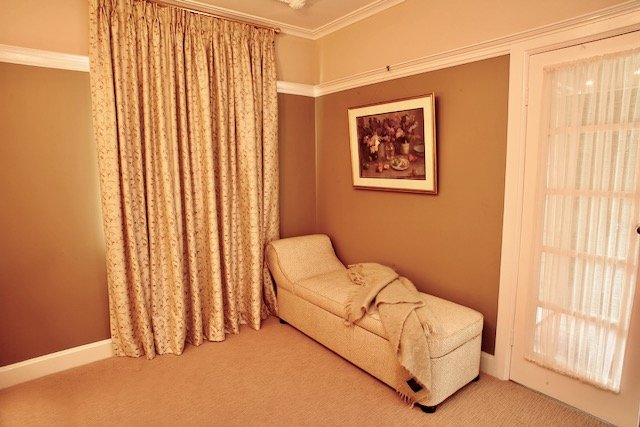Which Window Coverings Will I Choose?
This is one of the questions I’m often asked when I am decorating a home.
Like all things, there are just so many choices and it really depends on the homeowners as to what they like and what function the rooms will have. The style of the house and décor will also dictate the window coverings that suit.
However I do have a couple of guidelines that make choosing a little easier.
Roller blinds have been around for years. You can choose your own fabric and have it bonded onto a backing fabric to create a roller blind. That way you can match your décor and personalise the blind.
Roller blinds are either up or down. They have a thin roll at the top which is always on view unless you install a pelmet. They can be spring loaded, chain or cord operated and have a base bar or ring pull.
Roller blinds are ideal for kitchens, bathrooms or laundries. They are cost effective, so if you are wanting a covering but don’t want to spend a lot of money, they could be the answer. Where possible we tend to make the blind with a reverse roll so when raised the roll is hidden.
Sunscreen roller blinds are very popular as they allow light in but still provide thermal qualities as well as the ability to reduce glare. They provide privacy and give a streamlined look. We will often recommend sunscreen roller blinds in family living areas so the view is not diminished and light still enters the room.
For children’s bedrooms, I usually recommend roman blinds. They sit in the window reveal or just outside the architrave so do not fall to the floor which is ideal if a bed or other furniture sits under the window.
Any fabric can be made into a roman blind which means the blind will add a splash of colour or texture to the room. Blockout lining can be added to create maximum light control however light will still enter down the sides of the blind.
Roman blinds are operated by a cord which is secured around a cleat that is screwed into the wall. Australian safety standards dictate the cleat must be at least 150cm above the ground so the cord down not become a hazard to children.
Curtains provide the best insulation as well as the best light control capabilities when blockout lining is added. The styles are endless but the most important aspect is to not be stingy with the amount of fabric. It will make a big difference to the way the curtain hangs an looks.
Consider the style of the heading of the curtain as well as the length. Personally, I prefer curtains that hang to the floor as short curtains can look stingy. If there is furniture in the way, then usually I would recommend a blind rather than a curtain but of course, each room needs to considered and sometimes short curtains work.
Curtains that puddle can harbor dust and bugs as well as become tripping hazards for pets and children (and as in my case, clumsy husbands). My preference is for curtains that “kiss” the floor i.e. they sit just above the floor. Curtains are a more formal look so suit formal lounge rooms, dining rooms and main bedrooms.
Shutters are a smart, streamlined option which are custom made to suit the window, They can be painted in any colour, however most companies provide a standard range of colours with custom colours incurring a surcharge, Where possible we try to choose a colour from the standard range to help control costs.
Shutters can make a room look clinical especially if there are limited soft surfaces in the room so soften the look with fabric sofas, rugs or carpet and textured cushions.
Each panel is usually split horizontally so if privacy is an issue, or the view is unsightly, the bottom section can be closed while the top section can be tilted to allow light and air to enter the room. Shutters are a good option if occupants have allergies.
There are many other alternatives but these are the ones I usually have clients requesting.










